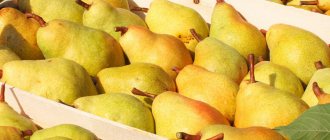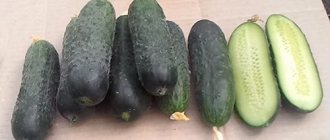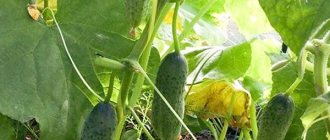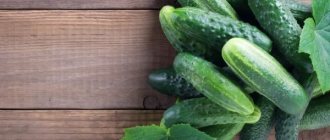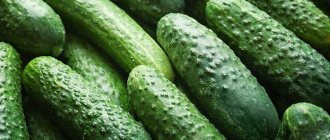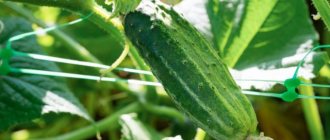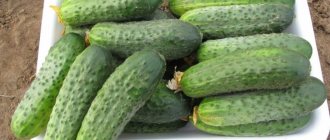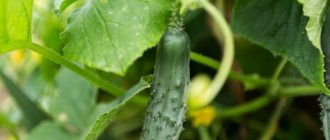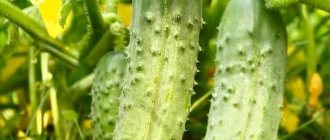Vegetable growing » Cucumbers
0
3747
Article rating
Kira Stoletova
The Kolibri F1 cucumber variety stands out due to its hybrid origin. This variety is grown to produce pickles and gherkins. Cucumbers have good immunity and do not require special care.
Characteristics of cucumbers of the Kolibri F1 variety
Description of Hummingbird cucumbers
The plant is of an indeterminate type; the State Register describes it as low-growing. But in greenhouses, the height of the main stem of a cucumber can reach 2.5 meters, and the bushes themselves are much more powerful. At the same time, Hummingbirds have rather weak branching. Although the variety has many side shoots, they are short and of a determinate type.
The foliage is average. The leaves are small, green, long-petiolate, with a slightly wrinkled surface. The leaf blades are located horizontally relative to the soil surface. The internodes of the main vine are very short, this allows the formation of a large number of ovaries, as a result of which the yield increases.
The type of flowering is predominantly female. In each leaf axil, mainly 4 to 5 ovaries are formed (according to the State Register). The originators in their description call the number of ovaries from 2 to 8 - 10 pieces in the axil, classifying the hybrid as a superbunch crop. Despite the large number of ovaries in a bunch, all cucumbers ripen, since fruit formation in Hummingbird occurs sequentially.
The variety's greens are short, gherkin-type, 5 - 8 cm long, 3.0 - 3.7 cm in cross section, spindle-shaped, on a long stalk. The color of the fruit is bright, green, with short light stripes. The surface has barely noticeable ribbing, is medium-lumpy, the frequency of the tubercles is moderate, the pubescence is light, of medium density. The pulp is dense, crispy, tender and juicy, does not contain even traces of bitterness, the aroma is present. The taste is good, sweetish. The seeds are very small, at the stage of milky ripeness, and are practically not felt during consumption. Cucumber weight 60 - 80 grams.
Varietal features
The Kolibri f1 cucumber variety has the following advantages:
- high yield - about 9 kg/m²;
- early ripening – ripening occurs within 40 days;
- universal application - planting can be carried out both in a greenhouse and in open ground;
- good resistance to adverse climatic conditions, diseases and pests.
The bush is parthenocarpic, there is a high rate of shoot growth, female inflorescences predominate. An average of seven ovaries are formed in each leaf axil. If harvesting occurs unevenly, the fruits do not outgrow.
According to the description, the average weight of the fruit is 70 g, inside there is crispy pulp and small seeds, there is no bitterness. Harvesting is carried out every two days; if fruiting is abundant, the fruits are collected daily.
All this characterizes this variety as very beneficial for cultivation.
Distinctive features
The most important indicators of a hybrid:
- the first harvest is harvested after 40 days;
- suitable for planting both in open ground and in greenhouses;
- It is resistant to pests, diseases and adverse weather conditions.
See the photo below for the shape of the fruit.
Description of the bush
The Kolibri variety is a highly productive parthenocarpic plant. The root system of the hybrid is of a taproot type, highly branched, with numerous lateral branches developing on the large main root. The stem is branched, up to 30 cm in height, creeping and climbing. The bush is characterized by bunch weaving; the plant also produces many tendrils, thanks to which it can independently attach to a support.
The growth of green mass occurs quite quickly, the lateral sinuses are small. The leaves on the stem are bright green, heart-shaped, divided into 5 lobes. The bush blooms together; the hybrid does not require a pollinator. Each leaf ovary produces 2–8 fruits.
The bushes are parthenocarpic. The weaving is in bunches, the shoots grow quickly. The lateral shoots are small. The plant has female flowers. Each node in the leaf axil forms from 2 to 8 ovaries. If the fruits are harvested unevenly, the greens do not outgrow.
The dark green foliage is small in size and parallel to the soil. The bush is indeterminate, the internodes of the main stem are short.
Description of fruits
Greens of the Kolibri variety have the following commercial qualities.
Characteristics of cucumber fruits:
- length - 5-8 cm;
- diameter - 2.5-3.5 cm;
- weight - 60-80 g.
The fruit pulp is crisp, without cavities or bitterness. The seeds are small or completely absent. The shape is cylindrical, narrowed towards the stalk. The surface of the fruit is covered with small bumps and white spines. There are also longitudinal light stripes on the skin.
To grow pickles, cucumbers are harvested daily after fruiting begins. The gherkins are harvested every 2 days.
Seeds can be planted both in open and closed ground. The lashes in the open area are covered with film; trellises are used for convenience: this speeds up development. Before planting on the site, the seeds are germinated. By planting seeds using the seedling method, you can get fruits earlier than the specified dates.
Productivity depends on care
Hummingbird F1 cucumbers do not require special care, but following the rules contributes to the development of a high-quality harvest. To grow strong cucumber fruits, you need to pay attention to:
- watering mode;
- fertilizer;
- loosening and formation of bushes.
The hybrid produces multi-seeded gherkin-type fruits with juicy and crispy pulp, rich green color, with pimply skin. Also, characteristic light stripes can be observed on the surface of cucumbers. Bitterness is not inherent in fruits. The shape of the cucumber is cylindrical, elongated. The average length of the fruit is 5–8 cm, and the diameter does not exceed 3.5 cm. Cucumbers are not prone to overgrowth.
Did you know? The cucumber first appeared in cultivation about 6 thousand years ago. The plant began to be grown in the territory of modern India and the Himalayas, where it is found in the wild today.
Composition, properties, benefits, calorie content
The vegetable is known for its beneficial qualities for the body due to the content of vitamins B, C, folic acid and trace elements: iron, potassium, iodine, silver, calcium and many others.
Care
Seeds can be planted both in open and closed ground. The lashes in the open area are covered with film; trellises are used for convenience: this speeds up development. Before planting on the site, the seeds are germinated. By planting seeds using the seedling method, you can get fruits earlier than the specified dates.
Productivity depends on care
Hummingbird F1 cucumbers do not require special care, but following the rules contributes to the development of a high-quality harvest. To grow strong cucumber fruits, you need to pay attention to:
- watering mode;
- fertilizer;
- loosening and formation of bushes.
Watering
Cucumbers need a lot of moisture. Before active flowering begins, it is necessary to apply 5 liters in dry weather and 2 liters after precipitation. During fruiting, cucumbers require up to 8 liters of water during drought and 5 liters after rain.
It is necessary to water the bushes in the morning with warm water. Evening watering when planting in spring can cause cooling of the root system due to unstable temperatures.
Loosening
Precipitation and irrigation lead to the formation of a hard crust on the soil surface. Its appearance can slow down the development of lashes. After watering, the soil is loosened.
The root system of cucumbers is close to the surface of the earth, so hilling and weeding should be done carefully.
Fertilizers
Fertilizing is applied at least once during the period of active growth. Mixtures containing nitrogen, potassium and magnesium are used as fertilizers. Some additionally fertilize the bushes during irrigation.
Organics are popular for feeding bushes:
- infusion of onion peel;
- dairy products;
- diluted chicken droppings or animal manure.
Organic animal feeds attract harmful insects. You cannot use chicken droppings or manure as fertilizer if neighboring gardens are infested with mole crickets or whiteflies.
Trimming
Fruits need sunlight
Forming a bush allows the vines to receive the maximum amount of sunlight. This improves the quality of the fruit. Only the lower side shoots should be cut off, while keeping the central stem and other vines intact: they form ovaries that participate in the formation of cucumbers.
Characteristics of the Hummingbird cucumber variety
Hummingbird cucumbers get their qualities thanks to their hybrid origin. As a result of painstaking work, a universal fruit plant was obtained, capable of producing high yields with almost any agricultural technology.
According to the description, Kolibri F1 cucumbers have a number of distinctive characteristics:
- fruitfulness - 9 kg per 1 sq. m;
- ripening time is 38-40 days, due to which the variety is considered early ripening;
- versatility of use.
Hummingbird cucumbers grow in temperate climates. The culture tolerates adverse weather conditions well. This variety is also suitable for balcony growing.
Disease resistance
The Hummingbird variety cucumber has innate and stable immunity to many crop diseases.
Resistance to olive spot and cucumber mosaic is noted. But if growing conditions are unfavorable, fungal spores may spread and infect the fruit.
To minimize the risk of disease spread, it is recommended to carry out special treatment of bushes using the following substances:
- a solution of milk, iodine and laundry soap will help protect plants from powdery mildew;
- treatment with milk and fermented milk products will help prevent the development of peronosporosis;
- a urea solution will help get rid of gray and white rot.
Ripening time
Hummingbird F1 is a fast-ripening fruit hybrid. The first harvest can be harvested within 35 days after sowing, and full fruiting occurs approximately on the 40th day after sowing the seeds.
Features of fruiting
The variety is characterized by high productivity, the average fruit weight is 60–80 g. At the same time, about 9 kg of cucumbers can be harvested from 1 m² of plantings. The maximum biological yield does not exceed 13 kg/m², however, for this the plant must be grown in conditions close to optimal.
Productivity
Productivity indicators are from 11 to 13 kg of cucumbers per 1 m2.
Advantages and disadvantages of Hummingbird cucumbers
The main advantages of the variety:
- excellent productivity;
- unpretentiousness;
- tolerates unfavorable conditions;
- the plant can be cultivated in open soil, and even on a windowsill;
- fruits do not tend to overgrow;
- has high resistance to cucumber mosaic and powdery mildew, as well as average resistance to downy mildew;
- the crop is suitable for fresh consumption, as well as for preservation;
- Cucumbers are distinguished by their high shelf life and transportability.
The main disadvantages of Hummingbird cucumbers:
- the plant cannot be grown from the seeds of the selected crop;
- fairly small fruits;
- when canning, cucumbers become soft;
- low germination of seed.
Advantages and disadvantages
Advantages of the Hummingbird hybrid:
- precocity;
- high productivity;
- excellent transportability;
- long fruit formation;
- immunity to disease;
- excellent taste;
- low maintenance requirements;
- not prone to overgrowth.
Disadvantages include:
- the need to form a bush and tie it up;
- inability to collect seeds yourself.
Super bunch cucumber Hummingbird
Agricultural technology or proper cultivation
Seed material can be sown both in open beds and in a greenhouse structure. Only germinated seeds are used for sowing. By giving preference to the seedling method, you can get an earlier harvest. They are sown and planted in greenhouses without heating in the second or third decade of May, in open beds - in early June (when grown in the middle zone).
In the south, sowing and planting are carried out in April-May. In greenhouse structures, no more than 2-3 plants are placed per 1 m2, in open beds - from 4 to 5.
Growing
The variety grows well in film and glass greenhouses. The plant can only grow outdoors in warm climates. Cucumber seeds "Masha F1" are blue/emerald/green. There is no need to prepare them before planting, as they are treated with a special compound. There is also no need to soak, otherwise all the properties of the pesticides will be lost.
Cultivation of cucumbers “Masha F1” is carried out by seedlings and without seedlings:
- The seedling method allows for early harvesting. It is necessary to create favorable conditions for growth (t – 28C, humidity and light). For seedlings, it is better to choose peat pots, peat tablets or improvised means (since the root system is weak, it may suffer during replanting). In the early stages of life, the plant will be in favorable conditions and may become stronger. After this, you can transplant the cucumbers to a permanent place.
- In open ground, seeds are planted only in heated soil, the temperature of which is at least 15 degrees. The soil is prepared in advance (loosened, fertilized, moistened). Place the seeds in holes 1.5-3 cm deep. Then water and mulch for better germination.
It is preferable to choose light soil with sufficient humus content for growing cucumbers. The area should be well lit, protected from wind and scorching sunlight.
For growing, it is better to choose the trellis method. It is more advantageous and convenient for collecting fruits and caring for them. Using this method, cucumbers are planted according to the scheme - 100x20cm. It is possible to use the method in a spread pattern - 60x80cm. But this way the vines become intertwined, making harvesting more difficult, and the risk of disease increases.
In greenhouses, these hybrid cucumbers grow well, but require a little more attention, since closed soil is of lower quality and can be affected by harmful microorganisms. They develop well there due to the favorable microclimate. Therefore, gardeners:
- Disinfection is carried out. use sulfur bombs, block all cracks and leave for 5 days. This method even eliminates slugs and ticks.
- Change the top layer of soil 2-3 times a year. It is better to do this in the fall, and do not forget to feed the soil with organic fertilizers.
- Cucumber seedlings are planted in greenhouses earlier. than in open ground. Before planting, the soil is pre-warmed by covering it with black plastic film. Planting pattern – 100x20 cm (trellis method).
Landing Features
This variety grows and develops well in both open and closed soil, including in garden pots. That is why the hybrid is one of the most unpretentious representatives of the genus. However, in order to obtain healthy, high-yielding plants, one must not only create the required microclimate for them, but also provide the seeds with the necessary preparation.
Did you know? Cucumbers gained particular popularity back in ancient times. This fruit is mentioned even in ancient biblical scriptures as one of the main vegetables of the Egyptian state.
Optimal sowing dates
The optimal period for sowing seeds of this variety is considered to be the second half of spring. The most suitable time lasts from the end of April to the second half of May. At an earlier time, young seedlings will not be able to receive the necessary lighting, which will subsequently lead to elongation of the bushes and brittleness of the stems.
Sowing in the first half of summer will lead to a shortening of the growing season, which will reduce the yield of the bushes significantly. When growing on a windowsill, the timing of sowing can be neglected, but for this, cucumbers must be additionally illuminated and regularly fed.
Soil selection and preparation
Cucumbers are grown on loose and nutritious soil, which is mixed from purchased soil for flower plants, compost or humus and perlite (4:1:1). As an alternative, you can use any lightweight soil for seedlings with a neutral pH value (6–7). Moreover, such a substrate must necessarily be based on peat or humus.
Before sowing, the soil must be sterilized - this makes it possible to avoid cucumbers from being affected by infections and pests.
Sterilization is carried out in any of various ways, but the following methods are most often used:
- spilling boiling water;
- roasting in the oven (+120...+130°C, about 20 minutes);
- cold storage (–20…–25°С, for 3 days);
- treatment with bactericidal agents (2% solution of potassium permanganate, copper sulfate or formaldehyde).
Seed treatment
Before sowing, the seeds must also be sterilized - this best helps protect young plants from infectious diseases.
Different methods are also used for this. Most often, seed material is kept in the following means:
- 2% solution of potassium permanganate (20–30 minutes);
- 70% alcohol solution (5–10 minutes);
- fungicide "Fitosporin" or "Baksis" (1-2 hours).
In the presence of large-scale crops, soaking in sterilizing solutions is irrational, so it is replaced by heating. To do this, the seeds are kept in an oven or a special drying cabinet at a temperature of +40°C for 3 days. To speed up the procedure, the temperature can be increased to +80°C, while the heat treatment is carried out for about 24 hours. Immediately before planting, the seed is treated with growth stimulants. Thanks to this, not only their germination capacity increases, but also the rooting activity.
This procedure is carried out over 6–8 hours, using the following drugs:
- “Agate” (4–7 g/l);
- "Baikal" (1:1000);
- “Sodium humate” (0.3 g/l).
Agricultural technology
Our hero provides vegetable growers with a large selection of growing methods. In addition, Hummingbirds can be planted directly with seeds in the ground or seedlings. Therefore, the timing of sowing or planting will be different. So, seeds or 25-day-old seedlings are planted in an unheated greenhouse from May 15 to May 20. In open ground - from June 1 to June 5. These terms are suitable for central Russia. In the southern regions, sowing or planting is carried out earlier - in April and May. The planting density varies depending on the location. In protected soil, it is recommended to plant 2.5 - 3 bushes per 1 square meter; the density in an open garden bed may be slightly higher - 4 - 5 plants per the same area. Caring for cucumbers is standard, including timely watering, fertilizing, weeding and loosening. Don't miss the moment when the plant needs to be tied to a support or trellis. The variety is formed into 1 stem using the standard pattern.
The good thing about hummingbird is that it can be used for growing in spring and summer on balconies, loggias and verandas. For one plant you will need a small container with a volume of 5 - 6 liters. Care is also no different, except for one nuance. A small volume of soil dries out much faster when the temperature rises, so you will have to water the plant more often. To moisturize, use only warm water to avoid shocking the cucumber roots. In cool regions, gardeners have successfully grown the crop in a barrel filled with compost, where the plant is warm and has enough nutrients.
The Hummingbird hybrid is a very interesting, one might even say versatile, crop. It is suitable not only for gardeners, but also for city dwellers who also want to grow vegetables with their own hands. An unpretentious and disease-resistant variety will not take much time from a vegetable grower, even a beginner. And he will definitely thank you with a rich harvest of delicious cucumbers, which are good both natural and canned. No significant drawbacks were identified in the variety, except for the need for staking and plant formation. Another unpleasant nuance is the need to purchase cucumber seeds annually.
Back and forth
Features of caring for the variety
Like any fruit plant, the Hummingbird variety requires proper care. This hybrid requires not only watering, fertilizing and soil care, but also timely formation. Without this, the crop can turn into a low-yielding wild bush.
Watering
Good care will increase plant productivity.
Hummingbird f1 cucumbers are unpretentious to growing and care conditions, but to increase fruiting you should follow certain rules:
- regularly clear the beds of weeds;
- loosen the soil at least once a week;
- water every three days;
- tie up the shoots of the plant as they grow;
- pinch the main stem after the 7th leaf appears;
- harvest regularly.
Experienced gardeners recommend watering plants with warm water using a watering can. Do not water with a hose. Also, water only the soil, not the plant itself.
It is better to water as the soil dries, but at least once every 3-4 days. It is best to irrigate the soil in the morning. Such care will promote uniform growth of the fruit.
Top dressing
Proper care also includes regular fertilization. When growing the Hummingbird variety in greenhouse conditions, fertilizing is applied 5 times during the growing season. For this purpose, organic and mineral substances are used.
The application scheme for the first time after transplantation to a permanent place is simple. You need to take the following components:
- urea;
- potassium sulfate;
- superphosphate.
All substances are in equal proportions, they are mixed, then liquid mullein is added to them.
When the first cucumbers appear, water the plants with a solution based on water, nitroammophoska, or chicken manure. If it is not possible to add mullein or other substances, you can purchase ready-made compositions for feeding.
Soil care
The soil also requires special care when cultivating cucumbers. The beds need regular weed removal, loosening and mulching. Weeding and loosening are often combined - this makes it possible to simultaneously remove weeds and saturate the soil with oxygen, which ultimately reduces the negative impact of the environment on the bushes and increases fruitfulness. You need to weed and loosen cucumber beds once a week, the day after watering.
Mulching allows you to create a favorable soil microclimate for plants, as well as reduce labor costs for watering and weeding. They begin mulching 2–3 weeks after planting, and then mulch is added as needed. Sawdust, crushed bark, spruce needles and other natural materials are used as a protective layer.
Important! The root system of cucumbers is located in the upper layers of the soil, so you need to loosen the plantings to a depth of no more than 5–7 cm.
Garter and bush formation
Traditional agricultural technology for growing cucumbers requires staking. The most effective way to secure bushes is to tie them to a trellis. To do this, a horizontal rod with vertical supports is fixed above each bed. Since the height of each bush does not exceed 30 cm, the overall structure should be no higher than 50 cm.
A strong twine is lowered from the rod to each plant and attached to a peg at the base of the plant. Throughout its development, the plant is woven into twine, which becomes the main support for the cucumber. You can replace the trellis with individual wooden or metal pegs.
You can begin to form a bush 2-3 weeks after planting. Plants with 1 powerful stem and several lateral branches have the highest productivity. Therefore, as the bush grows, all the lower stepsons need to be cut off up to the 3rd pair of leaves. After this, half of all shoots are removed, leaving the top intact.
If necessary, thin out the foliage on the bushes. This helps speed up the growth of fruits and also increase the amount of harvest. Removal is carried out as the cucumbers grow - all leaves shading the fruit must be pruned. It should be remembered that no more than 30% of the foliage can be removed in this way, otherwise the bushes will die.
Description of the universal hybrid
Cucumber Hummingbird F1 - refers to hybrids that do not require insect intervention to form fruits. The plant can be cultivated in greenhouses, on balconies, loggias, and unprotected beds. Culture is indeterminate.
The lateral processes grow actively, but most of the stepsons are completed after 3 leaves. At the end of each braid a productive inflorescence is formed. The leaves are small in size. Internodes are 6-7 cm. The inflorescence produces from 2 to 10 fruits.
The cucumber has the shape of a short cylinder. Its skin is moderately tuberous, with light spines. The tip of the hybrid is lighter than the other parts. Yellowish stripes extend from it, reaching the middle of the surface of the vegetable (see photo).
| By type of growth | Medium-climbing |
| By type of branching | Weakly branched |
| Pollination type | Parthenocarpic |
| Disembarkation scheme | 50x50 cm |
| Weight, length and shape of the fruit | 60-80 g, 5-8 cm, round cylinder, green |
| Ripening time | Early ripening (35 – 48 days) |
| Usage | Universal |
| Drop off point | OG/greenhouse/greenhouse/balcony/loggia |
| Diseases | Immunity to olive spot, false and true leucorrhoea, cucumber mosaic virus |
| Flowering type | Predominantly female |
| Productivity | 9 – 13 kg/m2 |
Features of harvesting and storage
The first fruits ripen approximately 6 weeks after emergence. At this time, the first harvest is carried out, after which the fruit is selected every 2 days. By this time, the cucumbers should have lengthened to 5–8 cm. It is best to pick the crop in the morning or evening, on a dry and sunny day.
You need to separate the ripe fruit from the stalk using a sharp kitchen or garden knife. Then the collected cucumbers need to be placed in baskets or deep containers for vegetables - they serve as temporary containers, from which the fruits are subsequently delivered to a permanent storage location. Manipulations with fruits are carried out carefully; during selection they should not be damaged, as this sharply reduces their presentation and shelf life.
Selected fruits are stored in a dry and cool place at a temperature of about +5°C for 1 month after selection. Without special conditions, the shelf life of Kolibri cucumbers is no more than 14 days, and at the same time the taste and aromatic properties of the crop gradually decrease. To preserve the harvest of cucumbers throughout the winter, it is better to pickle them.
Kolibri F1 cucumbers are a productive fruit hybrid, unpretentious and high-yielding. This variety can be successfully grown both in open soil or greenhouses, and on a windowsill. And if you take into account all the features of growing this crop, you can regularly get an excellent harvest of fresh cucumbers.
Reviews
Most gardeners characterize cucumber on the positive side:
- “The culture does not need special care. The yield is very high, the fruits are small and tasty” - from the review of the gardener Marina.
- “Cucumbers never outgrow, there is no tendency to diseases,” notes farmer Gordeeva.
- “A cucumber without voids and bitterness,” says Alla from Russia.
- A gardener from Cherepovets is pleased with the rapid ripening of vegetables. However, it indicates that when salted the hybrid loses its elasticity.
The Kolibri F1 cucumber is capable of providing tasty fruits to a family that does not have its own plot of land. For a professional farmer, the crop will provide a harvest sufficient for personal consumption and sale.
Diseases and pests
Difficulties with growing the Hummingbird variety of cucumbers arise quite rarely. Usually the cause of problems is non-compliance with agricultural technology and general rules for growing crops. In this case, both dangerous fungi and all kinds of insect pests may appear in the beds.
The most common infectious diseases of the Hummingbird variety:
| Name | Fighting methods |
| Anthracnose | Sick bushes are sprayed with solutions of copper oxychloride (4 g / 1 l of water), and treatments are carried out every 10–12 days until the infection is completely eliminated. |
| Bacteriosis | The pathology can be overcome by spraying with copper oxychloride (4 g/l of water), with an interval of 10 days, until complete recovery. |
| Downy mildew | Plants are treated twice with highly active fungicidal preparations (Acrobat MC, Ridomil MC, Kurzat R) with an interval of 14 days. |
| Sulfur and white rot | Plantings are sprayed with urea solution (1 g / 1 l). It is applied to the beds once a week until the manifestations of rot are completely eliminated. |
Typical crop pests:
| Parasite name | Remedies |
| Thrips | The plantings are treated with the preparations “Aktellik”, “Confidor”, “Karate” |
| Ticks | They fight the pest by spraying with Actellik or Talstar. |
| Aphid | Treatment of plants with Confidora or Karate solution will help eliminate the pest. |
| Bedbugs | Affected plantings are treated with the insecticide “Karate” or “Confidor” |
Diseases
Hybrids of the F1 series have innate immunity to many common diseases, such as olive spot and cucumber mosaic. However, under unfavorable growing conditions, cucumbers can become infected with fungus.
Treatment of bushes for preventive purposes is carried out once a season. Solutions of mineral origin are applied before the formation of ovaries. Organic matter can be used until the end of fruiting.
The early maturity of the crop does not allow the use of heavy agrochemicals: such mixtures make greens toxic.
Treatment
Most solutions are prepared at home from available ingredients:
- Powdery mildew is considered the most common disease of cucumbers. A similar disease occurs due to hypothermia of the roots. An excess of nitrogen elements in the soil may also be the cause. Preventive measures include treating the root systems with a solution of milk, iodine and laundry soap.
- Downy mildew appears in places with high humidity. The disease affects the foliage with a brown coating and leads to the death of the plant. Fermented milk products help prevent the onset of disease.
- Gray and white rot damage the stem and roots of bushes. Excess moisture is also a cause. A urea solution helps fight infection. 10 g of the drug are diluted per 10 liters of water.
Pests
For species of hybrid origin, pests pose a greater threat than diseases. Some insects destroy the stems and roots of plants during the growing season, while others attack fruits. The most common pests are spider mites and slugs. These insects cause significant damage to the crop, destroying both the fruits and the bushes themselves.
You should not give up on prevention, as this will help protect crops from pests.
Prevention
Pest prevention is carried out during autumn soil preparation. Before the onset of cold weather, dig up the earth without breaking large clods of earth. During frosts, weed seeds and larvae of harmful insects die.
You can also plant onions, garlic and dill between the rows: the smell of these plants repels pests. Before growing seedlings or sowing in open ground, the seeds are calcined to strengthen the immunity of future plants.
Landing
This hybrid can be grown in open ground, in greenhouses, and even on a windowsill if there is no space. In cool regions and the northern zone, seeds are pre-planted for seedlings in order to get a harvest earlier. Planting dates depend on where the cucumbers are planned to be grown:
- to plant seedlings in a greenhouse, seeds are sown in early or mid-April;
- for planting in open ground and light film shelters - at the end of April or beginning of May;
- seeds are sown directly into greenhouse soil in May;
- Seeds are planted in open ground at the end of May or beginning of June, when the soil warms up to +14 degrees to a depth of at least 12 cm.
For seedlings, a special substrate based on humus or peat is used. You can prepare it yourself by mixing equal parts of garden soil, humus, peat and drainage (sand, sawdust or vermiculite). The soil is spilled with boiling water, a two percent solution of potassium permanganate or copper sulfate.
Hybrid seeds do not need to be treated with anything, since the manufacturer has already done this. Place 1-2 grains in each container, cover with a 1.5-2 cm layer of soil and moisten it. Germinate in warmth, then reduce the temperature to +18-20 degrees.
They are transplanted to a permanent place when the bushes have at least 3 leaves and the soil warms up to +15 degrees. For 1 sq. m place 3 plants in a greenhouse and up to 5 in open ground.
Farmers' reviews about the variety
Tomato Hummingbird mainly enjoys positive reviews from experienced and novice gardeners.
Farmer reviews about tomato:
Martynenko Karina, Moscow: “Hummingbird is my favorite variety. I am reaping a bountiful harvest. From 1 sq. meter produces at least 10 kg of tomatoes. I use them for winter preparations and for salads.”
Turner Andrey, Voronezh: “I plant hummingbirds to store them for the winter. Pickled tomatoes do not crack and have a lot of pulp. Really easy to care for and produce a lot of fruit. In my opinion, it’s too sour for salads; I like pink varieties fresh.”
How to grow your own
The hummingbird is adapted to any soil, as long as it is saturated with humus and well aerated. The good thing about the hybrid is that it can grow not only in vegetable gardens and greenhouses, but is also suitable for balconies and flowerpots.
Even a beginner can grow a vegetable on his own; you just need to choose the most appropriate sowing method and observe the growing conditions.
Planting by seeds and seedlings
The site where it is planned to grow cucumbers is prepared in the fall. To do this, it is dug up and fertilized with phosphorus-potassium and organic fertilizers. If the bed had to be prepared in the spring, when digging, add compost, humus, and complex mineral fertilizers, according to the instructions. Cucumber is a heat-loving vegetable, so choose a place that is sunny and protected from adverse weather conditions.
The optimal time for planting seeds in open ground is from the end of April to the second half of May, depending on the region. If you sow earlier, the shoots will not receive sufficient light, which will lead to the plant stretching and weakening.
Later sowing can lead to a shorter growing season and reduce yields several times. In an open area, make 4-5 holes per 1 square. m. In protected ground, 2-3 plants are placed in the same volume.
Experienced gardeners recommend growing cucumbers using seedlings to achieve earlier fruit appearance.
To grow seedlings do the following:
- Prepare the seeds in advance by calibrating them, keeping them at low temperatures, and treating them in a solution of potassium permanganate.
- A solution is prepared from ash and nitroammophoska and water, and seeds placed in a cloth bag are dipped into it.
- A day later, the seeds are removed, washed under running water, and placed on a damp cloth for two days.
- After swelling, they are planted in separate containers.
Before planting seedlings in a permanent place, they are watered, fertilized, and when the ground warms up, they are planted in the ground.
The beds are placed at a distance of 65-70 cm from each other, holes are made in them at a distance of 20 cm, they are filled with water, they wait until it is absorbed into the ground, then they begin to plant seeds or seedlings.
Growing and care
After 6-7 leaves appear, the main stem is pinched - this increases the yield. As the bush grows, it is tied to a support, the beds are kept clean, and weeds are removed if necessary. In order to speed up the growth of fruits, the leaves are thinned out and those that shade the fruits are removed.
At night, young shoots are covered with film or other material in case the temperature drops.
Cucumber is a moisture-loving plant that requires regular watering and care. Before the plant begins to bloom, add 5 liters of water per square meter. m in dry weather and 2 liters after precipitation. During the fruiting period, the water rate is increased by 2-3 liters. It is better to water the plants in the morning, with warm water, so as not to overcool the roots. It is recommended to do this with a watering can and not with a hose; the soil is moistened with water, but not the plant itself.
To prevent the formation of a crust on the surface of the soil after watering, which slows down the development of stems, the soil around the roots is loosened. This is done as carefully as possible; the root system of cucumbers is located close to the surface of the soil and may be damaged when loosened.
The harvest is harvested as the fruits ripen; unpicked cucumbers prevent the formation of a new ovary.
Fertilizers are applied several times throughout the growth cycle. The first feeding is carried out two weeks after planting. For this purpose, mixtures containing potassium, nitrogen, and magnesium are used. An infusion of onion skins, diluted manure or chicken droppings, and fermented milk products are suitable as organic fertilizers. Fertilizers are applied at the root, at the rate of 1.5 liters per 1 square meter. m beds. To saturate the soil with potassium, use a solution of wood ash, adding 0.5 liters under each bush.
Features of cultivation and possible difficulties
A special feature of caring for Hummingbird cucumbers is the need to form and tie up the bushes; without this, the plant goes into wild growth and becomes low-yielding.
Growing tomatoes
Tomato Kolibri is a greenhouse variety. In a greenhouse, you can get the most abundant harvest. At the same time, the plants are resistant to heat and frost.
Hummingbirds are easy to care for, rarely get sick, and have good yields even in the absence of regular feeding. A novice gardener can easily cope with growing a hybrid.
Planting seedlings in the ground
The seedlings are transplanted into an unheated greenhouse two months after the seeds germinate. Planting takes place in the middle or end of May. By this time, the morning frosts have already subsided.
Compost and ash are added to the soil for planting tomatoes. Undiluted manure should not be added; such fertilizer will lead to the death of tomatoes.
Plants are buried down to the cotyledon leaves. This creates a powerful root system.
Planted according to the 70X50 pattern. Placing tomatoes too close will reduce the yield and increase the risk of pests and diseases.
The first watering is five days after transplanting the tomatoes into the greenhouse. Before this, you need to loosen the ground around the bushes.
Nuances of care
Watering is an important point in plant care. Performed in the morning once a week. In hot weather, the number of weekly waterings is increased to 3 times and the soil is regularly loosened. This will ensure air flow to the roots.
The manufacturer recommends forming Kolibri into two stems - this increases the yield.
New shoots on bushes must be removed. You also need to deal with the leaves at the bottom of the plant, yellowed and wilted greenery.
Stepping is done in the morning. On the day of the procedure, the plant is not watered.
The Hummingbird tomato is a crop with constant growth, and therefore requires obligatory garter.
Growth stimulants improve the quality of bushes and accelerate the formation of ovaries. For these purposes, nitrogen, phosphorus and potassium fertilizers are used once every 2 weeks.
A solution of boric acid is a foliar feeding that will accelerate the appearance of fruits. Complex fertilizers can also be used for tomatoes.
Growing Tips
Experienced gardeners give effective advice:
- Carefully weed the weeds around the bushes. They can lead to the death of cultivated plants.
- Use gloves when picking tomatoes. The juice of this plant can cause an allergic reaction if it comes into contact with the skin.
- Once a week you can spray the leaves of the plant with water. More often it is impossible to avoid infection with late blight.
Disease and pest control
The Kolibri tomato is resistant to most existing diseases, which makes it easier to care for and reduces the need for chemical treatment.
Despite the fact that the hybrid is resistant to many plant diseases, it is often attacked by insects. Therefore, it is necessary to take measures in advance to combat pests.
The first step in insect control is to remove all weeds to avoid attack by mole crickets and slugs.
Aphids love tomato greens. Timely treatment of the bushes with a weak soap solution will save you from it.
To prevent the plant from getting late blight, monitor the humidity level in the greenhouse, preventing it from increasing. To do this, carry out regular ventilation.
